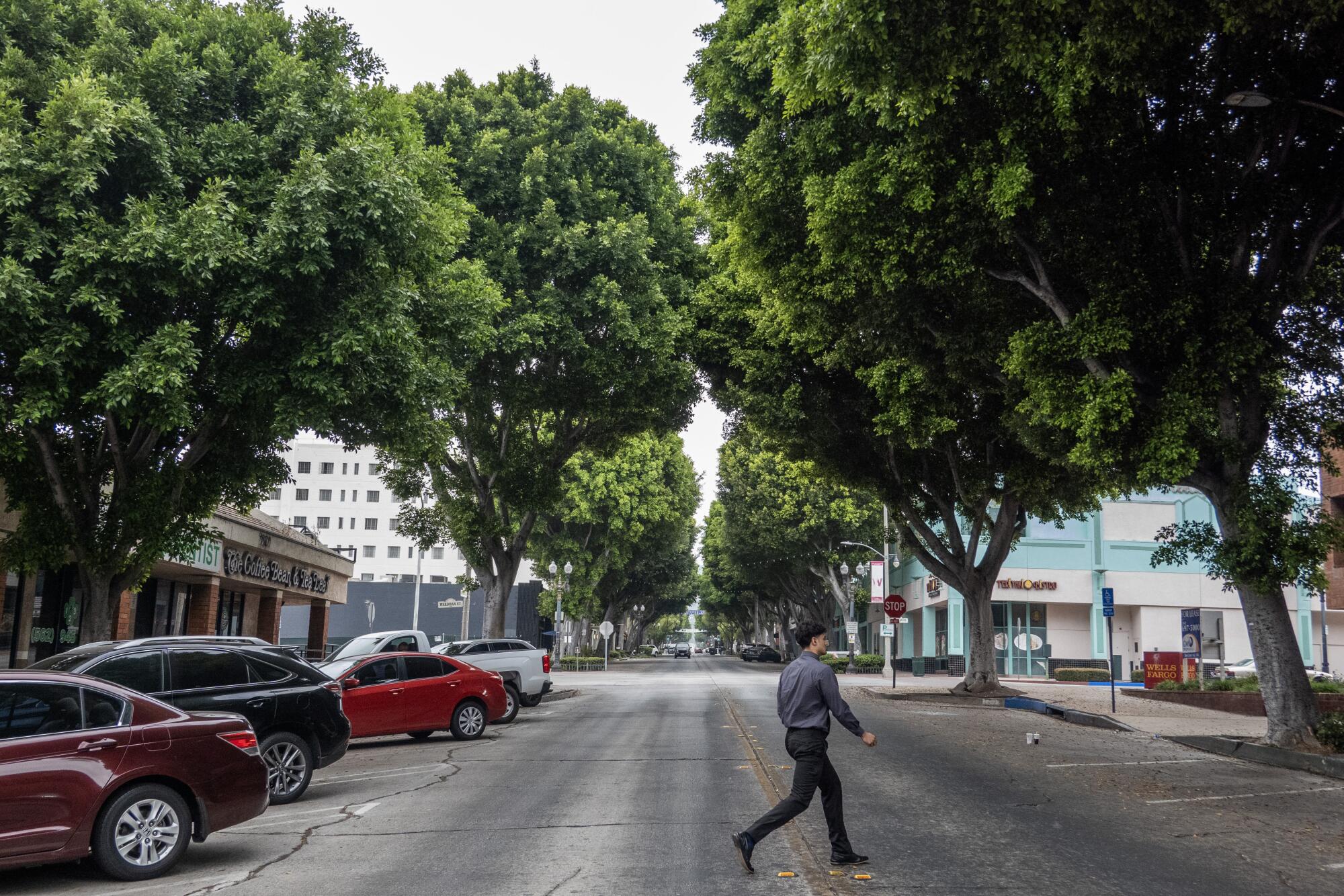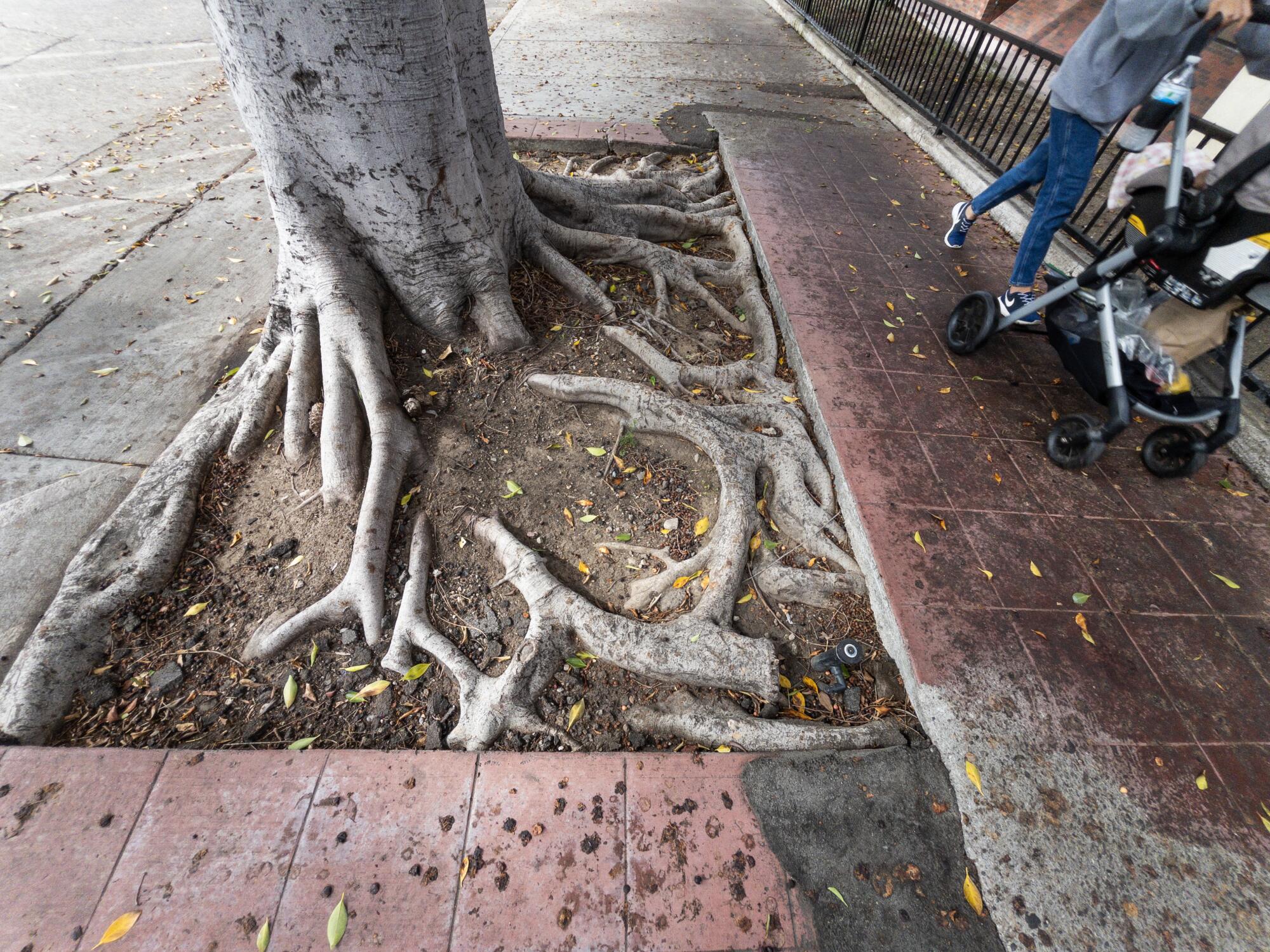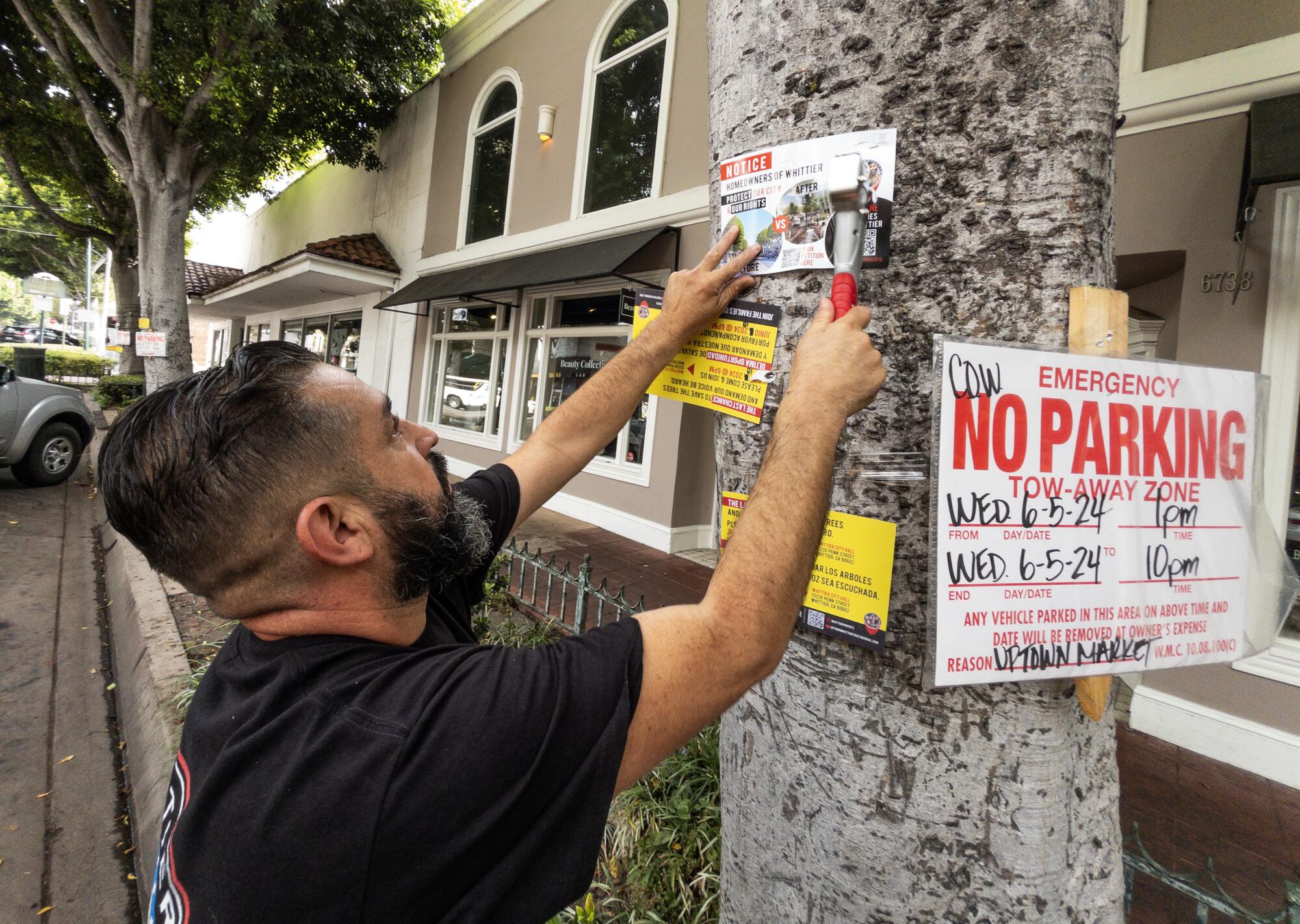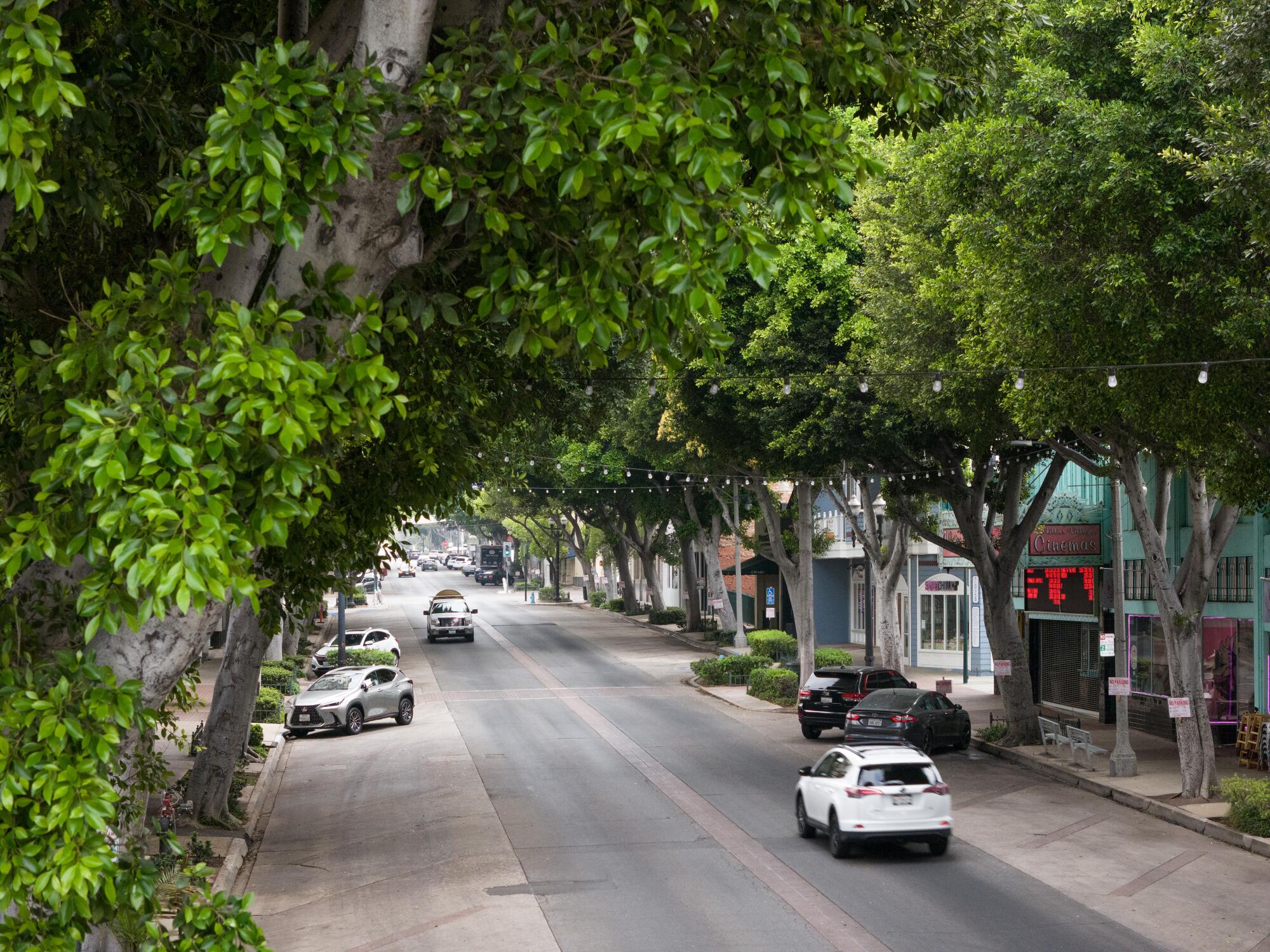The city of Whittier will move forward with removing 83 fig trees as part of a redesign of its commercial center, despite a flood of opposition to the plan.
City council members voted 3-1 Tuesday night to move forward with a $20 million redevelopment project in Uptown Whittier that calls for the cutting down of all of the fig trees in the three-block project area.
The decision comes after months of public outcry over the fate of the trees, following approval for the construction of Greenleaf Promenade in mid-December.
The project has been touted as a way to make the area more pedestrian-friendly and boost its economy, but some residents don't think sacrificing towering trees with their cooling canopy and majestic views is a reasonable trade-off.
City leaders noted the potential health and safety issues the trees pose but said they are hopeful they will eventually be replaced.
“I'm looking forward to revitalizing Uptown with new trees, new architecture, new lighting and new paving. I think it will be something we can all be proud of,” City Councilman Fernando Dutra said before voting in support of the project.
Mary Ann Pacheco, who recently joined the city council, was the lone dissenting vote. She said the plan creates a negative impression but could be fixed with an overhaul of the planning process.
“There's a perception within the city that it was done the wrong way, it was done for the wrong reasons,” she said. “I'm not saying that it was, but until that real problem is addressed, the trees will continue to be what we call a 'problem.'”
The dispute over the trees has divided the community, pitting some business owners against residents and among themselves, and there have even been calls to boycott businesses seen as condoning the trees.
Trees are synonymous with the quiet community's character in eastern Los Angeles County, and some praise them for providing shade and absorbing greenhouse gases in a warming world.
Some argue that invasive trees will lift sidewalks or clog sewers with their roots, while others are willing to sacrifice them to get ground on projects they believe will boost the economy.
At a recent meeting, more than 40 speakers passionately offered public feedback, nearly all of whom opposed tree removal.
In public comments, Helen Larder, executive director of the Whittier Conservation Society, called the plan “absurd.”
“That's in your hands. You have the power to do it. Revisit the plans and include trees,” she said. “We have to go back to square one on this. The local community is not going to accept this.”

Greenleaf Avenue in Whittier on June 5, 2024. While some people blame the trees for sidewalk and plumbing problems, others enjoy the shade they provide.
(Myung J. Chung/Los Angeles Times)
The meeting lasted about four hours and was filled with tensions, with members of the audience yelling abuse at staff and Mayor Pro Tem Kathy Warner calling two recesses amid the commotion.
As the meeting was wrapping up, someone shouted, “You guys are the worst!”
In their comments, several City Council members expressed disappointment at the hostile tone of the discussion both inside and outside City Hall.
At the meeting, city council members approved modifications to the project, including replacing trees slated for removal with larger ones than originally envisioned and adding more umbrella structures to cover sidewalks — changes that appear to address concerns about the potential loss of tree canopy and shade, which could increase carbon sequestration.
Consultants hired by the city say carbon sequestration would drop significantly in the first year the current canopy is replaced, and original plans project it would break even after 24 years.
“In this scenario, planting larger trees would bring about a quicker breakeven point,” said Alan Assimone of Michael Baker International, an environmental consultant for the firm. “If you plant larger trees, they will grow faster and sequester more carbon earlier in their lives.”
City officials also explored options for phasing the project over time and answered more than 50 questions raised in public comments, including about liability hazards posed by the trees, environmental documentation and historic street lighting.
“We're not giving up!” resident Connie McCormack said in a text message the day after the meeting. Ms. McCormack, who has led the anti-logging movement, has threatened legal action.
Ever since residents learned of the plans to cut down their trees, they have been coming out in droves, holding rallies and circulating petitions protesting the simultaneous cutting of trees to make way for the Greenleaf Promenade.

In uptown Whittier, some residents support removing the fig trees because their roots can lift sidewalks and get into sewer systems.
(Myung J. Chung/Los Angeles Times)
City leaders took notice: The protests prompted two more recent tree-focused “study sessions.”
City officials say necessary grading and other construction factors make it impossible to save any of the fig trees.
At the meeting, Mayor Brian Saeki said the city cannot cut down all the trees because there are tree protection zones, areas around the trees “where construction work cannot be allowed without endangering the health of the trees.”
Officials said other types of trees that line the street may also be saved.
One thing widely agreed upon is that Uptown Whittier, considered the city's heartland, needs some care. It was last renovated in the 1980s, including after the 1987 Whittier Narrows earthquake, which devastated the area.
The envisioned walkway, as its name suggests, would stretch along Greenleaf Avenue from Wardman Street to Hadley Street and would include wide sidewalks, outdoor dining and gathering spaces, street furniture and decorative lighting.
City officials are “committed to revitalizing Uptown Whittier into a vibrant, walkable, pedestrian-friendly neighborhood that can be enjoyed by residents for generations to come,” Saeki said in a statement last month. He said certain trees in the project area would need to be cut down to realize a “long-held vision.”
“We understand the community's concerns and appreciate the feedback we've received,” Saeki said, adding that the city will plant larger replacement trees “wherever possible,” as well as add 39,000 square feet of understory landscaping and 18,000 square feet of new park space.
A similar, smaller-scale pilot project was approved in 2019 but canceled due to the pandemic, city officials said. The one-block “Gardens of Uptown,” with an estimated cost of $3.8 million, differed from the other projects in what some considered key: It preserved a colony of fig trees.
The project has morphed and expanded over the years in response to changing tastes sparked by the pandemic, city officials said. Greenleaf Promenade cost roughly five times as much as the pilot project.

Last month, Javier Garcia posted a notice urging local homeowners to protect the fig trees on Greenleaf Street.
(Myung J. Chung/Los Angeles Times)
Despite all this, Uptown Whittier maintains a small-town feel, with Greenleaf Avenue lined with family-run businesses like Lovell's Records, which has been around for more than 70 years, and newer establishments dotted around, like bar and restaurant La Sexy Michelada.
Currently, controversial fig trees (thought to have been planted in the late 1960s) provide shade across the street. Some of the pros and cons of fig trees are clearly on display: When you step outside with their branches spread out on a warm day, you prepare yourself for intense sunlight. But when you walk under the trees when the figs are falling, you step in organic mud.

The controversial trees in Uptown Whittier are believed to have been planted in the late 1960s and some consider them central to the neighborhood's character and look.
(Myung J. Chung/Los Angeles Times)
Whittier isn't the only one wrestling with fig ambivalence.
Beverly Hills cut down more than 50 fig trees as part of a sidewalk renovation project, but then a judge issued a temporary restraining order ordering the city to stop the cutting down. After the ruling, the city decided to prepare an environmental impact statement for the project, but work is still ongoing.
In 2018, Pasadena city officials held a meeting to gather community input on whether to continue planting fig trees and how it would affect Greene Street. Last March, the volunteer group Pasadena Beautiful Foundation reported planting 30 fig trees on the street.

